The inquest concluded Thursday evening in Saskatoon, offering four jury recommendations as well clarity and closure for grieving families.
Published Mar 02, 2024 • Last updated 13 hours ago • 7 minute read
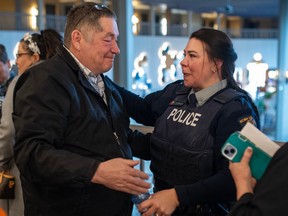 RCMP Constable Heidi Marshall, right, hugs and speaks with Darryl Burns, whose sister Gloria was one of the people killed on James Smith Cree Nation, following the second day of the inquest into the apprehension and death of Myles Sanderson. Marshall was the RCMP officer who ultimately drove into Sanderson’s stolen vehicle during the high-speed chase, pushing him off the road. Photo by Liam Richards /The Canadian Press
RCMP Constable Heidi Marshall, right, hugs and speaks with Darryl Burns, whose sister Gloria was one of the people killed on James Smith Cree Nation, following the second day of the inquest into the apprehension and death of Myles Sanderson. Marshall was the RCMP officer who ultimately drove into Sanderson’s stolen vehicle during the high-speed chase, pushing him off the road. Photo by Liam Richards /The Canadian Press
Warning: This story contains disturbing and graphic details some readers may find upsetting.
•••••
Article content
The coroner’s inquest into the death of a Saskatchewan mass killer brought clarity, and some closure, to grieving communities.
On Sept. 4, 2022, Myles Sanderson killed 11 people and injured 17 others during a stabbing rampage on James Smith Cree Nation and in the nearby village of Weldon.
Advertisement 2
This advertisement has not loaded yet, but your article continues below.
THIS CONTENT IS RESERVED FOR SUBSCRIBERS ONLY
Subscribe now to read the latest news in your city and across Canada.
Unlimited online access to articles from across Canada with one account.Get exclusive access to the Saskatoon StarPhoenix ePaper, an electronic replica of the print edition that you can share, download and comment on.Enjoy insights and behind-the-scenes analysis from our award-winning journalists.Support local journalists and the next generation of journalists.Daily puzzles including the New York Times Crossword.
SUBSCRIBE TO UNLOCK MORE ARTICLES
Subscribe now to read the latest news in your city and across Canada.
Unlimited online access to articles from across Canada with one account.Get exclusive access to the Saskatoon StarPhoenix ePaper, an electronic replica of the print edition that you can share, download and comment on.Enjoy insights and behind-the-scenes analysis from our award-winning journalists.Support local journalists and the next generation of journalists.Daily puzzles including the New York Times Crossword.
REGISTER / SIGN IN TO UNLOCK MORE ARTICLES
Create an account or sign in to continue with your reading experience.
Access articles from across Canada with one account.Share your thoughts and join the conversation in the comments.Enjoy additional articles per month.Get email updates from your favourite authors.
Sign In or Create an Account
or
Article content
Days later, on Sept. 7, Sanderson died in police custody, minutes after being arrested. This followed an extensive manhunt that ended in a high-speed chase down the highway towards Saskatoon.
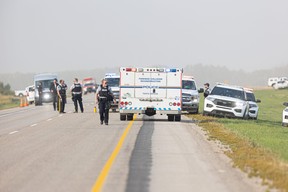 RCMP on scene on Highway 11 after the arrest of Myles Sanderson north of Saskatoon.
RCMP on scene on Highway 11 after the arrest of Myles Sanderson north of Saskatoon.
The inquest into the deaths of Sanderson’s victims took place three weeks ago in Melfort, and resulted in a staggering 29 recommendations from that coroner and jury.
Here are five key questions addressed at this second inquest, which focused entirely on Sanderson’s death:
Where was Myles Sanderson between Sept. 4 and 7, 2022?
After Sanderson killed his last victim on Sept. 4, 2022, he went into hiding.
Over the next four days, more than 600 phone calls and tips about his location flooded in from across the country. Three of those reports placed him between the hamlet of Crystal Springs and the town of Wakaw.
And on the afternoon of Sept. 7, a woman from that area reported that a man had broken into her home wielding a knife, smashing a window and kicking down a door to get to her.
“She’s really panicked,” a local RCMP sergeant told his dispatcher, as heard on a call recording. “She says the guy broke in and took her vehicle, and she’s alleging that it’s Myles Sanderson.”
Advertisement 3
This advertisement has not loaded yet, but your article continues below.
Article content
The woman told officers Sanderson had demanded cigarettes, water and the keys to her vehicle. He also wanted her to come with him, but she refused.
Later, the RCMP found signs that Sanderson had made camp near the woman’s house and had been hiding there since the killings, stealing food, drinks and bedding from her garage.
But that afternoon, once he was behind the wheel of the stolen vehicle, a white Chevrolet Avalanche, he headed for Saskatoon.
How was Myles Sanderson caught?
The report of the break-in put police on Sanderson’s trail, and they started tailing him down the highway.
When Sanderson realized he was being followed, he started driving south in the busy northbound lane, hitting speeds close to 170 kilometres an hour as oncoming drivers scattered into the ditch.
RCMP Supt. Devin Pugh, the critical incident commander on duty, knew the officers in pursuit weren’t trained to ram vehicles at high speeds — but he said they had to get Sanderson off the road before anybody else got hurt.
So he gave the order:
“Take the vehicle down if the opportunity exists to end the threat.”
By signing up you consent to receive the above newsletter from Postmedia Network Inc.
Article content
Advertisement 4
This advertisement has not loaded yet, but your article continues below.
Article content
When Const. Heidi Marshall heard those instructions, she understood she might die in the attempt.
“We were southbound at those high speeds, the thing that I remember thinking at the time was ‘what’s going to happen to my kids?’ ” she said, tearing up during her testimony. “Am I going to leave them without a mom?”
But when Sanderson crossed over into the southbound lane, Marshall saw a chance to stop him. Accelerating to nearly 140 kilometres an hour, she hit the Avalanche’s back bumper.
As Sanderson spun into the ditch, a surprised-sounding Marshall came over the radio to report:
“I got him.”
Later, when Pugh watched the footage of what Marshall had done, he was amazed.
“It was textbook,” he said.
After Marshall’s emotional testimony, more than a dozen people from James Smith Cree Nation stopped to thank her, or hug her, for her heroic actions that day.
And Eddie Head — Myles Sanderson’s uncle, representing his family at the inquest — made sure Marshall knew she would always be welcome on James Smith Cree Nation as they all work on healing together.
“We certainly support you for what you’re doing, and keep up the good work,” he said. “And when you’re on the road, come and talk to us.”
Advertisement 5
This advertisement has not loaded yet, but your article continues below.
Article content
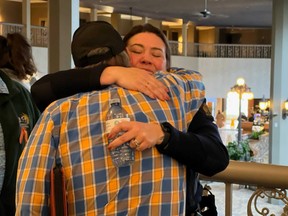 Eddie Head embraces RCMP Const. Heidi Marshall after her testimony at the coroner’s inquest into the death of Myles Sanderson on Feb. 27, 2024. (Submitted by Lisa Risom)
Eddie Head embraces RCMP Const. Heidi Marshall after her testimony at the coroner’s inquest into the death of Myles Sanderson on Feb. 27, 2024. (Submitted by Lisa Risom)
What happened after Myles Sanderson’s arrest?
Almost all of the video and audio footage of Sanderson’s last moments, from the moment of his arrest to when he collapsed in medical distress, only exists due to the prescient decision of a single RCMP officer.
When Const. Travis Adema pulled into the ditch near the white Avalanche, he took a moment to adjust his vehicle’s camera — which had been pointing off into an empty field — towards Sanderson’s vehicle. He was the only officer on-scene to bring his personal microphone out of the vehicle.
These recordings show RCMP Const. Bill Rowley approaching the Avalanche and yanking open the driver’s-side door.
“I thought (Sanderson) was going to come out with either a knife or a firearm,” Rowley said. “I thought it was going to turn into a shootout.”
Officers shouted at Sanderson to “get on the ground,” “get out of the vehicle now,” “you’re under arrest,” and repeatedly ordered Sanderson to “show us your hands,” which he appeared to be moving from his face to the centre console and back again — as though he was ingesting something.
Advertisement 6
This advertisement has not loaded yet, but your article continues below.
Article content
Rowley and Adema pulled Sanderson to the ground, handcuffed him, and stood him up against a police vehicle.
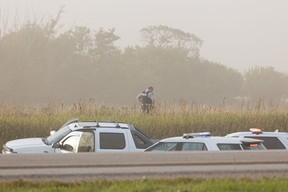 RCMP on scene on Highway 11 after the arrest of Myles Sanderson North of Saskatoon.
RCMP on scene on Highway 11 after the arrest of Myles Sanderson North of Saskatoon.
Stills from video taken at the scene show Sanderson after his arrest, on his feet while he was being searched, turning to look at Adema with a wide smile.
“His demeanour and attitude was very smug, cocky and arrogant,” Rowley said. “He was laughing. He was directing comments to us that we should have shot him, asking how many bodies he got.”
“I’m ready to die now,” Sanderson is heard telling the officers in the video,.
“You should have shot me,” Sanderson told the officers, speaking fast and high-pitched, repeating the sentiment multiple times in a variety of profanity-laced comments. “Shoot me, man.”
One officer responded: “Luckily, it didn’t have to come to that.”
But within minutes, Sanderson’s condition deteriorated: He swayed, stumbled and started breathing strangely.
“You should’ve shot me,” Sanderson gasped again, quiet and slurred.
“As I was about to put him inside (a police vehicle), his body felt like he actually stopped,” Rowley told the inquest. “He stopped dead in his tracks … And then I could feel his body tense up and start to shake.”
Advertisement 7
This advertisement has not loaded yet, but your article continues below.
Article content
How did Myles Sanderson die?
As officers lowered Sanderson to the ground, they called for EMS and asked him what he’d taken — they thought he said ‘meth.’
Then Sanderson lost consciousness and started to seize and bleed from his nose and mouth. Officers and paramedics quickly gave two doses of Naloxone and started CPR, but his condition never improved.
He arrived at the hospital without a pulse and was pronounced dead that same day.
Later, Sanderson’s autopsy showed an extremely high level of cocaine in his system when he died; according to a forensic pathologist, over 10 times a lethal dose.
Sanderson was an experienced cocaine user, and his medical records showed a history of suicidal thoughts. Despite that, psychologist Matt Logan did not think Sanderson’s death was a suicide.
“‘Why waste good cocaine?’ ” Logan said, explaining his view of Sanderson’s thought process. “‘If I’m going to go out, I’m going to go out my way.’ In our belief, he was not taking the cocaine in order to die, but he didn’t care whether he died or not …
“It is our belief that the cocaine toxicity was not an attempted suicide, but an accidental overdose.”
Advertisement 8
This advertisement has not loaded yet, but your article continues below.
Article content
What did the jury recommend?
On the evening of Thursday Feb. 29, 2024 — nearly a year and a half after Sanderson’s death — a six-member coroner’s jury came back with their findings and recommendations.
The jury determined that he died, accidentally, of acute cocaine toxicity, and made the following suggestions for what could be done differently in the future:
That the Saskatoon Police Service consider establishing a dedicated team tasked with arresting individuals who are subject to outstanding warrants;That the RCMP consider implementing mandatory enhanced driver training, including the PIT (precision immobilization technique) maneuver;That the RCMP consider reviewing its policy and criteria for high-speed pursuits, in the interest of the safety of all involved; andThat the RCMP consider implementing additional training in enhanced extraction techniques, for the purposes of arrest takedowns.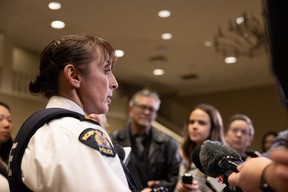 Rhonda Blackmore, commanding officer of the Saskatchewan RCMP, speaks during a press conference after the inquest into the apprehension and death of Myles Sanderson, who killed 11 people and injured 17 others on James Smith Cree Nation and the nearby community of Weldon back in September of 2022. (Michelle Berg / Saskatoon StarPhoenix)
Rhonda Blackmore, commanding officer of the Saskatchewan RCMP, speaks during a press conference after the inquest into the apprehension and death of Myles Sanderson, who killed 11 people and injured 17 others on James Smith Cree Nation and the nearby community of Weldon back in September of 2022. (Michelle Berg / Saskatoon StarPhoenix)
Sanderson’s uncle said this inquest has brought much-needed closure to the First Nation.
The video footage in particular, Eddie Head explained, offered irrefutable proof that the RCMP officers and paramedics who treated Sanderson that day had reacted quickly when he went into distress, and did all they could to try to save his life.
Advertisement 9
This advertisement has not loaded yet, but your article continues below.
Article content
Head also shared, now that his sister — Sanderson’s mother — knows the whole truth of what happened that day, she has been able to find some peace and move forward, surrounded by her family’s love and support.
“My sister wants to heal now,” he said. “What her boy did, it could have driven her into addiction. It could have driven her to suicide — she contemplated that, many times, and her family and her community is saying to her ‘no, don’t think like that.’ And today she could walk out of here and she’s asking to be with her family, and also participate in our cultural ways of healing.”
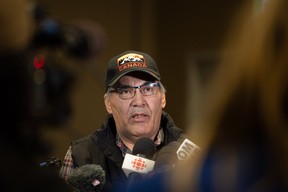 Eddie Head speaks to media after the inquest into the apprehension and death of Myles Sanderson, who killed 11 people and injured 17 others on James Smith Cree Nation and the nearby community of Weldon back in September of 2022. (Michelle Berg / Saskatoon StarPhoenix)
Eddie Head speaks to media after the inquest into the apprehension and death of Myles Sanderson, who killed 11 people and injured 17 others on James Smith Cree Nation and the nearby community of Weldon back in September of 2022. (Michelle Berg / Saskatoon StarPhoenix)
If you or someone you know is in immediate danger of self-harm or experiencing suicidal thoughts, please contact Crisis Services Canada (1-833-456-4566), Saskatoon Mobile Crisis (306-933-6200), Prince Albert Mobile Crisis Unit (306-764-1011), Regina Mobile Crisis Services (306-525-5333) or the Hope for Wellness Help Line, which provides culturally competent crisis intervention counselling support for Indigenous peoples (1-855-242-3310).
Recommended from Editorial

‘Another level of protection’: Alert system unveiled by James Smith Cree Nation

How paintings by a James Smith Cree Nation artist bring beauty to tragedy
Bookmark our website and support our journalism: Don’t miss the news you need to know — add The StarPhoenix.com and LeaderPost.com to your bookmarks and sign up for our newsletters here.
Article content
>>> Read full article>>>
Copyright for syndicated content belongs to the linked Source : Saskatoon StarPhoenix – https://thestarphoenix.com/news/local-news/five-critical-questions-answered-by-the-coroners-inquest-into-the-death-of-myles-sanderson































